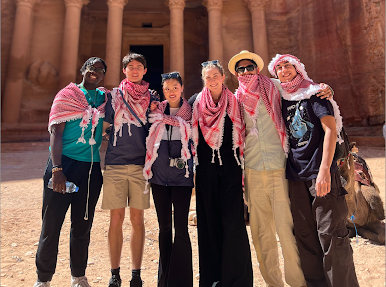Green ’24 and Nikol ’25, share reflections of their visits to Petra and Wadi Rum.
Petra was one of the stops that I was most excited to visit (I even bought a refrigerator magnet before I even set foot in Petra). I did a little bit of research on the bus ride and learned that the majority of Petra, once the capital of an Arab tribe called Nabataean, is still yet to be “re-discovered.” As we pulled up to the site’s entrance and cranked our necks to see through the window with anticipation, Mo, our tour guide, explained that the excavated facades are less than 20% of the entire “long-lost” city. Despite what may still lie underground (Mo told us that there is another level of buildings approx. 4m below of what is currently exposed), I stood in awe at the sight of the Treasury (Khaznah), which served as a royal tomb for the Nabataean king, through the gaps of the golden rocks of the Siq (the official, narrow pathway into Petra). As I approached the Treasury, I could make out more details of the façade that represented the various cultures that influenced Petra’s architecture: Greek, Roman, Babylonian, etc.
On our somewhat hasty promenade through the Siq, I made sure I was listening to Mo explain different carvings on the sandstone walls while furiously typing everything hear on my Notes app as well as finding good angles for aesthetic photos of the gorgeous masterpiece that I was walking in. After some time, however, I put down my camera and just let my eyes soak everything in – because the feeling of being present often cannot be expressed through pictures. As I looked up at the colorful layers of sedimentation in the rocks, I imagined Petra to be a flourishing trade center – the cosmopolitan NYC of the ancient times. Although the cultural diversity showed us that different religions can co-exist harmoniously (a blessing), it can also make it more difficult for present archeologists (a curse). For example, I learned from Mo that Petra adopted the Egyptians’ belief in the afterlife by carving their tombs inside the mountains so that the deceased would lay closer to the Nabataean’s mountain god. However, after converting to Christianity, a religion where people do not practice burials, they emptied out all the tombs. I wonder how much more information we could gather if there were still remains inside the Petra tombs. It’s interesting to think about how much longer the dead could live than the living if the living did not interfere with the dead.
-Green ’24

After a full lunch, we hopped on the bus to our next stop: Wadi Rum. Shortly after we hit the road, our bus filled with music and singing. While singing classics like “Rude!” by Magic and “Sky Full of Stars” by Coldplay, we stopped to admire the beautiful scenery outside the window. From high up the mountains, we saw a gorgeous view of Petra and Wadi Rum.
When we got to our destination, we switched out the bus for three trackbeds. Exited, we hopped on the jeeps and entered Wadi Rum. The “Senior Jeep” led the way as we followed. I loved driving through the desert and looking at the view of what used to be the bottom of the ocean. We were surprised when the trucks suddenly stopped.
As we exited the trucks, our guide told us that we could go up the sand dunes next to us. Some of us decided to run up. Even though I started running from the bottom, by the time I got to the top I was breathing heavily, nearly moving my legs. Turns out it’s hard to run in the sand! But it was all worth it because of the views we saw and the photos we took!
We made two more stops. One was at the place of Thamudi writing that was created between the 6th and 7th century BC. Another one was the sights of the picture that was created to commemorate Auda Abu Tayi who was the leader of the Howeitat or Huwaylat tribes and was one of the main figures in the Great Arab Revolt.
Afterward, we arrived at our camp. The first thing I did was head to the top of the dune nearby. The view was so magnificent I stayed there until I had to head to dinner. Before dinner, we gathered to see it being cooked. Our whole meal was being cooked underground! On the distance from one to one and a half meters underground, lined up with stones. We watched as they dug up the sand with shovels and took out delicious-looking chicken, lamb, and rice.
We had our meal sitting next to the fire, drinking bedouin tea, and talking on deep-hearted topics. We listened to beautiful live music. It didn’t take us long to start dancing dabkeh. Dabkeh is a Jordanian style of communal dance, in which everyone holds hands in a circle and follows a certain feet movement. I felt warm even in the desert cold because of how actively we danced. As we got tired we started singing. My Arabic I class and I tried singing the Jordanian song that we have known and loved since the beginning of the year: “Nassam Alaina Alhawa” by Fairooz. We finished the day lying on the sand and looking at the gorgeous Wadi Rum stars.
-Nikol ’25
